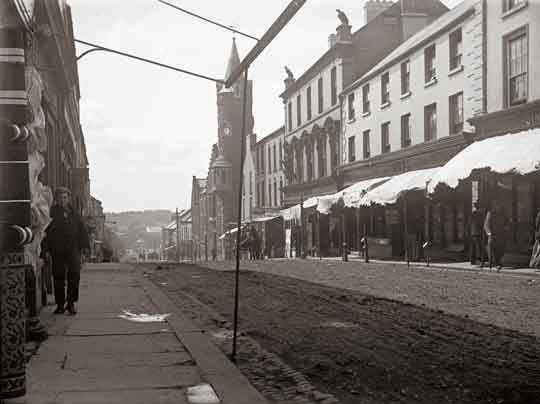Mid-Antrim Museum, The Braid, Ballymena, Mon.–Sat. 10am–4pm, until 30 September 2023
Mary Alice Macnaghten was born in 1867, the eldest child of the Rt Hon. Sir Francis Edward Workman-Macnaghten and Alice Mary Russell. They lived at Dundarave House, Bushmills, Co. Antrim. On 26 August 1893 Mary married William (‘Willie’) Robert Young, eldest son of the Rt Hon. John Young of Galgorm Castle, Ballymena. The Youngs were prosperous linen merchants. The couple had one daughter, Hilda Grace, born in 1896. In 1915 Mary Alice’s husband inherited Galgorm Castle and estate.

Pastimes for ladies like painting and needlework were popular with the gentry but Mary had instead taken up photography. Between 1890 and 1915, when First World War commitments left her no time for hobbies, Mary recorded all aspects of life at Galgorm Castle. She also photographed daily life when she visited friends and family at other ‘big houses’ across Ireland. She took over 1,000 photographs and this archive provides us with an insight into a way of life that was about to change.
The Youngs were deeply engaged in politics, especially the Home Rule crisis. Mary was sworn in as a justice of the peace on 14 May 1920 in Ballymena—one of the first women in County Antrim to be made a magistrate. She was elected to Ballymena Rural District Council in 1924. Willie died of a stroke in 1933. Mary’s widowhood was busy. In addition to her political and charitable activities, she travelled widely until the outbreak of the Second World War, visiting friends and relatives throughout Great Britain and Ireland. She died in 1946.
The ‘With an Artist’s Eye’ exhibition was developed through a collaboration between Mid and East Antrim Borough Council’s Museum and Heritage Service, the Public Record Office of Northern Ireland (PRONI) and Mary Alice Young’s great-grandchildren, the Rt Hon. Christopher Brooke of Galgorm Castle and his sister, Juliana Grose. In 1975 Mary’s daughter Hilda Grace had loaned over 1,000 images on glass plate negatives and celluloid to the care of the PRONI. On show in the exhibition are 100 of these cleaned, restored and now digitised photographs. The images can be grouped under several themes reflecting Mary’s social standing, personal interest and clear ability as a photographer. The romantic charm of some, especially those of her daughter, shows Mary’s skill in the use of light.
The Mid-Antrim Museum, as a social history museum, aims to help local communities explore local past lives, how they were lived and what the past can tell us about our lives today. Selecting one photograph of Ballymena (above/below) from the 100 on display, we can examine what it tells us about the times in which Mary Alice Young lived. We can date this photograph to the 1890s based on the clothing and what we can find out about the businesses from street directories. By the end of the nineteenth century Ballymena was a prosperous town, mainly thanks to the success of the linen industry. The photograph shows a multitude of shops lining the street, providing goods and services to the growing population who had moved into the town from the surrounding rural areas in search of work.
The railway had arrived in the town in 1848 but most travel was done on foot or by horse and cart. In The recollections of Mary Alice Young (Mid-Antrim Historical Group, 1996), she writes:
‘Bicycles and motors and buses and telephones and cinemas and wirelesses have altered the old world. I rode the first so-called safety-bicycle ever seen in Ballymena and little boys ran after me, calling out rude remarks, so that I had always to get off through the town.’
Note the filth of the road. In that era horse droppings were a major problem. This street scene was to change. The development of the public transport system, the growth in private car use and advances in the use of tarmacadam were soon to consign this problem to the history books.
On the left, at a distance, a woman is walking away from the camera wearing a shawl over her head. She is likely a mill girl or ‘millie’. Girls the same age as Mary’s daughter Hilda Grace worked in the local mills, including the Braidwater Spinning Mill owned by the Youngs, working as half-timers from the age of twelve. By contrast, Hilda Grace had a governess and attended North Foreland Lodge, Kent, a private boarding-school for girls. Aside from the social history details that we can glean, what did Mary Alice Young see through her lens when she took this image? What does the boy with the cap who is walking towards us (left) see when he looks at Mary Alice Young and her camera?
A BBC documentary, The Lost Photographs of Mary Alice Young, is available on BBC iPlayer until 28 January 2024.
